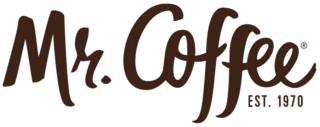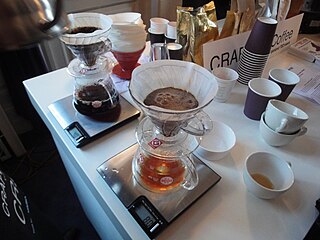Related Research Articles

A cappuccino is an espresso-based coffee drink that originated in Italy, and is traditionally prepared with steamed milk foam (microfoam).

Espresso is a coffee-making method of Italian origin, in which a small amount of nearly boiling water is forced under pressure (expressed) through finely-ground coffee beans. Espresso coffee can be made with a wide variety of coffee beans and roast levels. Espresso is generally thicker than coffee brewed by other methods, has a higher concentration of suspended and dissolved solids, and has crema on top. As a result of the pressurized brewing process, the flavors and chemicals in a typical cup of espresso are very concentrated. The three dispersed phases in espresso are what make this beverage unique. The first dispersed phase is an emulsion of oil droplets. The second phase is suspended solids, while the third is the layer of gas bubbles or foam. The dispersion of very small oil droplets is perceived in the mouth as creamy. This characteristic of espresso contributes to what is known as the body of the beverage. These oil droplets preserve some of the aromatic compounds that are lost to the air in other coffee forms. This preserves the strong coffee flavor present in the espresso. Espresso is also the base for various coffee drinks—including caffè latte, cappuccino, caffè macchiato, caffè mocha, flat white, and caffè Americano.

Brewed coffee is made by pouring hot water onto ground coffee beans, then allowing to brew. There are several methods for doing this, including using a filter, a percolator, and a French press. Terms used for the resulting coffee often reflect the method used, such as drip brewed coffee, filtered coffee, pour-over coffee, immersion brewed coffee, or simply coffee. Water seeps through the ground coffee, absorbing its constituent chemical compounds, and then passes through a filter. The used coffee grounds are retained in the filter, while the brewed coffee is collected in a vessel such as a carafe or pot.

Frappuccino is a trademarked brand of the Starbucks Corporation for a line of iced, blended coffee drinks. It consists of coffee or crème base, blended with ice and other various ingredients, usually topped with whipped cream and flavored syrups. Frappuccinos are also sold as bottled coffee beverages in grocery stores, convenience stores and from vending machines.

An espresso machine brews coffee by forcing pressurized water near boiling point through a "puck" of ground coffee and a filter in order to produce a thick, concentrated coffee called espresso. The first machine for making espresso was built and patented in 1884 by Angelo Moriondo of Turin, Italy. An improved design was patented on April 28, 1903, by Luigi Bezzera. The founder of the La Pavoni company bought the patent and from 1905 produced espresso machines commercially on a small scale in Milan. Multiple machine designs have been created to produce espresso. Several machines share some common elements, such as a grouphead and a portafilter. An espresso machine may also have a steam wand which is used to steam and froth liquids for coffee drinks such as cappuccino and caffe latte.

A burr mill, or burr grinder, is a mill used to grind hard, small food products between two revolving abrasive surfaces separated by a distance usually set by the user. When the two surfaces are set far apart, the resulting ground material is coarser, and when the two surfaces are set closer together, the resulting ground material is finer and smaller. Often, the device includes a revolving screw that pushes the food through. It may be powered electrically or manually.
Gevalia is the largest coffee roastery in Scandinavia. In North America, the company sells coffee directly to consumers via home delivery and through big box stores such as Wal-Mart. Gevalia discontinued sales of tea in 2015. Customers order from a customer service center and a website that was relaunched in August 2009. In North America, Gevalia is a wholly owned subsidiary of Kraft Heinz based in Chicago, Illinois. Gevalia produces more than 40 different varieties of coffee and tea.

Mr. Coffee is a registered trademark of Newell Brands. The Mr. Coffee brand manufactures automatic-drip kitchen coffee machines as well as other products. The brand was founded in the early 1970s. Mr. Coffee has often been referenced in popular culture and has been promoted by celebrities such as Joe DiMaggio.

La Marzocco, founded in 1927, Florence, by Giuseppe and Bruno Bambi, is an Italian company specializing in high-end espresso coffee machines. It is based in Scarperia, with branch offices worldwide.

Bunn-O-Matic Corporation is an American manufacturer of dispensed beverage equipment headquartered in Springfield, Illinois with a plant in Creston, Iowa. The company was founded in 1957 by George R. Bunn Jr., who invented the flat-bottom fluted coffee filter and the pour-over drip coffee brewer. Today, the corporation's products are sold under the BUNN and Bunn-O-Matic brands. The company's home coffeemakers are used throughout the United States and Canada, but the company's primary customers are institutional foodservice providers worldwide. The company introduced their first automatic drip-brew coffee maker in 1963. The company introduced their first drip brewer for the home market in 1972. The current president and CEO is Arthur H. Bunn.

Coffee preparation is the process of turning coffee beans into a beverage. While the particular steps vary with the type of coffee and with the raw materials, the process includes four basic steps: raw coffee beans must be roasted, the roasted coffee beans must then be ground, the ground coffee must then be mixed with hot water for a certain time (brewed), and finally the liquid coffee must be separated from the used grounds.

The moka pot is a stove-top or electric coffee maker that brews coffee by passing boiling water pressurized by steam through ground coffee. Named after the Yemeni city of Mocha, it was invented by an Italian engineer named Alfonso Bialetti in 1933 and quickly became one of the staples of Italian culture. Bialetti Industries continues to produce the same model under the name "Moka Express".
Thermoplan AG is a manufacturer of kitchen appliance for foodservice. The headquarters of the company is located in Weggis, Switzerland.

Cimbali is an Italian manufacturer of professional espresso and cappuccino equipment. All four of its production facilities are located in Italy. The company owns and produces LaCimbali, Faema, and Casadio machines and grinders.

A blade grinder, also known as propeller grinder, is a machine that chops material while mixing it, by means of a high-speed spinning blade. Applications of blade grinders for preparing foods include numerous electric kitchen appliances such as blenders, food processors, some garbage disposals, and some coffee grinders. The terms "blade grinder" and "propeller grinder" are in popular use to distinguish the blade grinder type of coffee grinder from other types. Other consumer applications include rotary lawn mowers.

Jura Elektroapparate AG is a Swiss developer and distributor of home appliances, headquartered in Niederbuchsiten, Canton of Solothurn. The company was founded in 1931 by Leo Henzirohs. Formerly, Jura ran its own factory, but it has outsourced production since the 1990s.

The Easy Serving Espresso pod, is a small packed coffee pod with a paper filter covering for use in a non-grinding espresso machine. The E.S.E. standard was created by Italian Illy in the 1970s and is maintained by the "Consortium for the Development and the Protection of the E.S.E. Standard." It is open to all coffee roasters and machine manufacturers, making it the self-acclaimed "only open system available to the sector for espresso coffee prepared with paper pods".

Coffeemakers or coffee machines are cooking appliances used to brew coffee. While there are many different types of coffeemakers using several different brewing principles, in the most common devices, coffee grounds are placed into a paper or metal filter inside a funnel, which is set over a glass or ceramic coffee pot, a cooking pot in the kettle family. Cold water is poured into a separate chamber, which is then boiled and directed into the funnel. This is also called automatic drip-brew.
Edmund Angel Abel, Jr. was an American engineer and inventor who designed and patented the heating element for Mr. Coffee, one of the first automatic drip coffee makers to be introduced to the American consumer market. Mr. Coffee, which was first sold in 1972, soon became the dominant coffeemaker in the United States, reaching sales of approximately $150 million by the late 1970s. Abel's invention, the heating element, brewed a milder coffee than traditional methods, largely replaced the percolator in American homes. Home Furnishings News listed Mr. Coffee as one of the most important household consumer products introduced in the previous seventy-five years in a list published in 2002. Prior to his work on the coffeemaker, he held patents in film developing and aviation. Despite his role in the invention of the Mr. Coffee machine, Abel did not drink coffee.
References
- Gambardella, Michael. [ [1] [https://web.archive.org/web/20120712103623/http://hfnmag.com/housewares/companies-rise].
- Kummer, Corby (2003). "The Joy of Coffee: The Essential Guide to Buying, Brewing, and Enjoying." Houghton Mifflin Cookbooks. pp. 115. ISBN 0-618-30240-9. Retrieved 2008-07-03.
- Samli, A. Coskun (2007). "Chaotic markets: thriving in a world of unpredictability". Greenwood Publishing Group. pp. 102. ISBN 0-275-99371-X. Retrieved 2008-07-03.
- Teschke, Deborah A. "IHA Board of Directors Welcomes Four New Members." "Www.housewares.org." 12 Sept. 2011. Web. 28 Feb. 2012. .
- Jura Capresso Company Description. "International Housewares Association for Retail and Wholesale Manufacturers and Buyers." International Housewares Association, 28 Feb. 2012. Web. 28 Feb. 2012. .
- Coffee king creates new outlet for espression (fee required). "The Washington Times". 1995-09-12. Retrieved 2008-07-03.